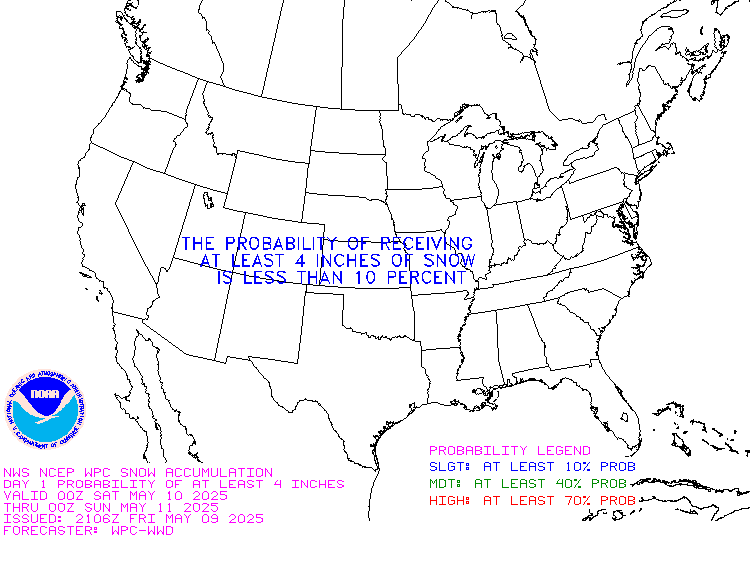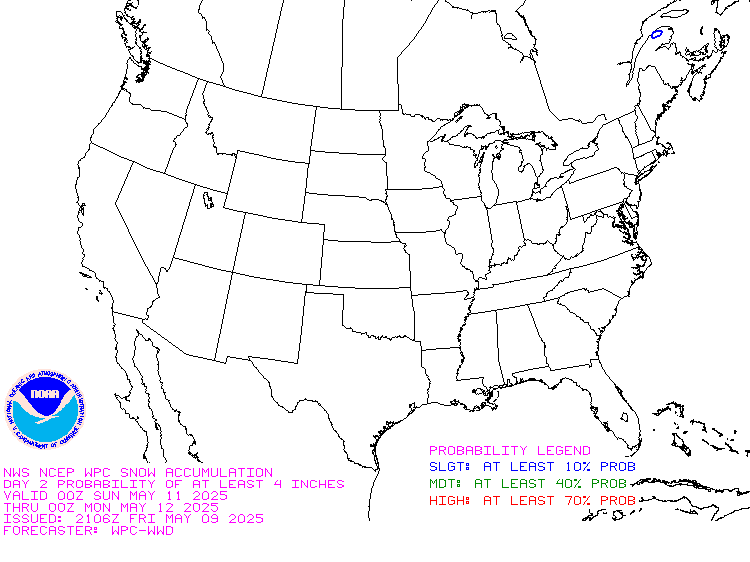It is difficult to find a more comprehensive Weather Outlook anywhere else with the ability to get a local 10-day Forecast also.
This article focuses on what we are paying attention to in the next 48 to 72 hours. The article also includes weather maps for longer-term U.S. outlooks and a six-day World weather outlook which can be very useful for travelers.
First the NWS Short Range Forecast. The afternoon NWS text update can be found here but it is unlikely to have changed very much. The images in this article automatically update.
Short Range Forecast Discussion
NWS Weather Prediction Center College Park MD
Tue Mar 12 2024
Valid 12Z Tue Mar 12 2024 – 12Z Thu Mar 14 2024…One more day of unsettled weather across the Pacific Northwest and
northern California before the precipitation gradually tapers off on
Wednesday……Mountain snows spreading into the northern and central Rockies on
Wednesday before heavy snow develops over central Colorado Wednesday
night……Fire danger across the southern High Plains will be followed by chance
of severe thunderstorms across the north-central Plains later on Wednesday
as rain may change over to wet snow in the nearby High Plains……Anomalously warm temperatures to expand eastward from the Upper Midwest
into the Ohio Valley, Mid-Atlantic and Northeast through Wednesday…A gradual shift in the large-scale upper-level pattern across the U.S.
will bring unsettled weather that has been impacting the Pacific Northwest
in recent days progressively eastward into the central U.S. by Wednesday
night. The final in a series of Pacific fronts and low pressure systems
will push onshore into the West Coast today, bringing additional mountain
snow and lower-elevation rain with one to possibly two feet of new snow
along the Cascades. As the main upper trough presses eastward through the
western U.S. the next couple of days, areas along the West Coast will have
a chance to gradually dry out on Wednesday. Meanwhile, the main batch of
moisture will penetrate farther inland in the form of mountain snow
pushing into the northern to central Rockies on Wednesday. The upper
trough will also help develop a low pressure system over the central High
Plains on Wednesday. The interaction of the upper trough with the
intensifying low pressure system will begin to organize and focus an area
of moderate to heavy snow over central Colorado by early on Thursday. By
Thursday morning, snow could be falling in earnest over the mountainous
terrain into the Front Range and nearby High Plains of central Colorado.On the warm side of the low pressure system, low relative humidity and
gusty winds will continue to raise the danger of wildfires across central
to southern High Plains today, followed by a more southward focus from the
Texas Panhandle to western Texas on Wednesday. The dry environment in the
Plains states will initially limit the formation of showers and some
thunderstorms across the mid-Mississippi Valley into the Midwest today
into early on Wednesday. However, as the low intensifies, influx of
moisture from the Gulf of Mexico is forecast to organize an area of
enhanced rainfall over the vicinity of Nebraska Wednesday night as the
storm center passes just to the southeast. Some of the enhanced rainfall
could be accompanied with severe weather. In addition, there is a
possibility that the western portion of the enhanced rainfall would change
over to wet snow early on Thursday if additional cold air wraps around the
storm center.Across the eastern U.S., the departure of a strong surface low near Nova
Scotia into the western Atlantic will allow the gusty winds to moderate
further across the northern Mid-Atlantic and Northeast today. Breezy
conditions are likely to remain for northern New England into Tuesday
night, but overall improvement is expected. High pressure over the
southern U.S. will slide eastward over the next couple of days, allowing
winds to return from the south, bringing warmer temperatures northward.
The greatest departures from normal highs will remain over the Upper
Midwest and Great Lakes region on Tuesday which may cause a few record
daily maximum temperatures to be broken, but the magnitude of the
anomalous warmth is likely to be lower on today compared to Monday. High
temperatures in the 60s to lower 70s will expand eastward through
Wednesday across the Ohio Valley and portions of the northern Mid-Atlantic
into the Northeast, roughly 15 to 25 degrees above mid-March averages.
With the warmer weather will come the threat for thunderstorms across
portions of the central U.S. Some severe thunderstorms will be possible
ahead of a dryline from eastern Oklahoma/Kansas into western Missouri on
Tuesday with a broader risk across some of these same areas on Wednesday.
Again, the prevailing dry environment will initially limit the intensity
of the storms.
To get your local forecast plus active alerts and warnings click HERE and enter your city, state or zip code.
Above is a 72 hour animation of the forecast. Learn about wave patterns HERE.
Then, looking at the world and of course, the U.S. shows here also. Today we are looking at precipitation.
Please click on “Read More” below to access the full Daily Report issued today.
| Notices: What would you like to learn about? Please provide that to me via the comment section at the end of the article. |
Now more detail on the 48-Hour Forecast (It is a 48 to 72 Hour Forecast actually)
Daily weather maps. The Day 1 map updates twice a day and the Day 2 and 3 maps update only once a day. These maps update automatically. But if that does not happen, you can get updates by clicking HERE
TODAY (or late in the day the evening/overnight map will appear) (Key to surface fronts shown on maps and you will then also be able to insert a city name or zip code and get a local NWS forecast).
TOMORROW
NEXT DAY
This animation shows how things may play out over the next 60 hours. To update click here.
The NWS Climate Prediction Center’s: Watches, Warnings, and Advisories plus other information can be found HERE. We post at least one of those updates daily, sometimes both. The Highlights are shown in the lede paragraph of this article.
ATMOSPHERIC RIVERS
This tells us what is approaching the West Coast. Click HERE to update If I have not gotten around to doing the update. Here is some useful information about Atmospheric Rivers.
Below is the current five-day cumulative forecast of precipitation (Updates can be found HERE)
Ski SnowReports
New Feature – Ski Reports. It is difficult to find reports that auto-update on-screen (and they are very long) but these links will get you to them – If you have additional suggestions make them in the comments section after every Econcurrents Article and we may add those links. We will try to not have too much overlap as that can add to the confusion.
Snow Forecasts. And remember this shows natural snow. Ski resorts also make their own snow.
Day 1

Day 2

Additional snow information can be found here, here, here, and here. The second link provides animations.
Now we look at Intermediate-Term “Outlook” maps for three time periods. Days 6 – 10, Days 8 – 14, and Weeks 3 and 4. An outlook differs from a forecast based on how NOAA uses these terms in that an “outlook” presents information as deviation from normal and the likelihood of these deviations.
Below are the links to obtain updates and additional information. They are particularly useful if you happen to be reading this article significantly later than when it was published. I always try to provide readers with the source of the information in my articles. These links may also be useful for those viewing this article on a cell phone or other small screen.
| Days 6 – 10 (shown in Row 1) | Days 8 – 14 (Shown in Row 2) | Weeks 3 and 4 (Shown in Row 3 but updates only on Fridays) |
| https://www.cpc.ncep.noaa. gov/products/predictions/610day/ | https://www.cpc.ncep .noaa.gov/products/predictions/814day/ | https://www.cpc.ncep.noaa.gov/products/predictions/WK34/ |
Showing the actual maps. They should now update automatically. The Week 3 – 4 Outlook only updates on Fridays. So below is what I call the Intermediate-term outlook. On Fridays, it extends out 28 Days. That declines day by day so on Thursday it only looks out 22 days until the next day when the Week 3 – 4 Outlook is updated and this extends the outlook by one additional week.
| 6–
10
|
|
|
| 8–
14 |
|
|
| 3–
4 |
|
|
HAZARDS OUTLOOKS
Click here for the latest complete Day 3 -7 Hazards forecast which updates only on weekdays. Once a week probably Monday or Tuesday I will update the images. I provided the link for readers to get daily updates on weekdays. Use your own judgment to decide if you need to update these images. I update almost all the images Friday Night for the weekend edition of this Weather Report. So normally readers do not need to update these images but if the weather is changing quickly you may want to.
Temperature month to date can be found at https://hprcc.unl.edu/products/maps/acis/MonthTDeptUS.png
Precipitation month to date can be found at https://hprcc.unl.edu/products/maps/acis /MonthPNormUS.png
World Forecast [that website is has been intermittent so be patient]
Below are the Day 1 -3 and 4-6 forecasts for temperature and precipitation. Updates and much additional information can be obtained HERE
World Temperature Anomalies
World Accumulated Precipitation
This information is provided by the University of Maine. They draw upon many different sources. There is a lot of information available at the link provided. I have just provided two useful forecasts. There are probably over a hundred different forecasts available from this source.
Worldwide Tropical Forecast (This is a NOAA Product)
This graphic updates on Tuesdays) If it has not been updated, you can get the update by clicking here Readers will only have to do that if they are reading this article much later than the date of it being published.
Information on Tropical Storms can be found HERE. Western Pacific information can be found HERE.
–
| I hope you found this article interesting and useful. |
–
